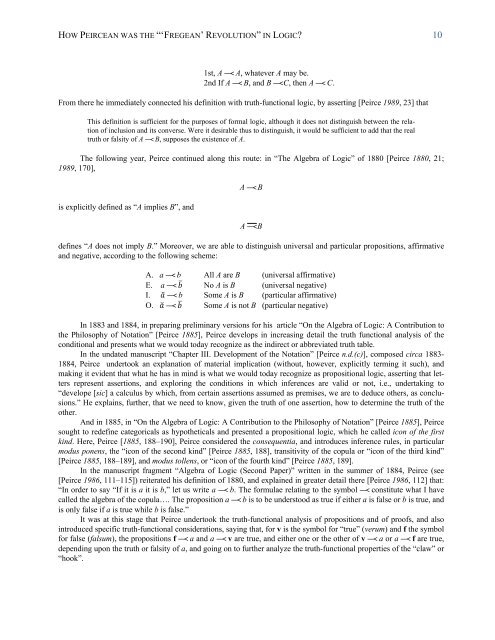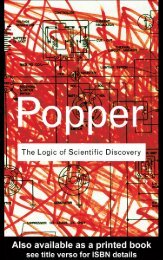Create successful ePaper yourself
Turn your PDF publications into a flip-book with our unique Google optimized e-Paper software.
HOW PEIRCEAN WAS THE “‘FREGEAN’ REVOLUTION” IN LOGIC? 10<br />
1st, A ―< A, whatever A may be.<br />
2nd If A ―< B, and B ―< C, then A ―< C.<br />
From there he immediately connected his definition with truth-functional logic, by asserting [Peirce 1989, 23] that<br />
This definition is sufficient for the purposes of formal logic, although it does not distinguish between the relation<br />
of inclusion and its converse. Were it desirable thus to distinguish, it would be sufficient to add that the real<br />
truth or falsity of A ―< B, supposes the existence of A.<br />
The following year, Peirce continued along this route: in “The Algebra of Logic” of 1880 [Peirce 1880, 21;<br />
1989, 170],<br />
is explicitly defined as “A implies B”, and<br />
A ―< B<br />
A ―< B<br />
defines “A does not imply B.” Moreover, we are able to distinguish universal and particular propositions, affirmative<br />
and negative, according to the following scheme:<br />
A. a ―< b All A are B (universal affirmative)<br />
E. a ―< �� No A is B (universal negative)<br />
I. �� ―< b Some A is B (particular affirmative)<br />
O. �� ―< �� Some A is not B (particular negative)<br />
In 1883 and 1884, in preparing preliminary versions for his article “On the Algebra of Logic: A Contribution to<br />
the Philosophy of Notation” [Peirce 1885], Peirce develops in increasing detail the truth functional analysis of the<br />
conditional and presents what we would today recognize as the indirect or abbreviated truth table.<br />
In the undated manuscript “Chapter III. Development of the Notation” [Peirce n.d.(c)], composed circa 1883-<br />
1884, Peirce undertook an explanation of material implication (without, however, explicitly terming it such), and<br />
making it evident that what he has in mind is what we would today recognize as propositional logic, asserting that letters<br />
represent assertions, and exploring the conditions in which inferences are valid or not, i.e., undertaking to<br />
“develope [sic] a calculus by which, from certain assertions assumed as premises, we are to deduce others, as conclusions.”<br />
He explains, further, that we need to know, given the truth of one assertion, how to determine the truth of the<br />
other.<br />
And in 1885, in “On the Algebra of Logic: A Contribution to the Philosophy of Notation” [Peirce 1885], Peirce<br />
sought to redefine categoricals as hypotheticals and presented a propositional logic, which he called icon of the first<br />
kind. Here, Peirce [1885, 188–190], Peirce considered the consequentia, and introduces inference rules, in particular<br />
modus ponens, the “icon of the second kind” [Peirce 1885, 188], transitivity of the copula or “icon of the third kind”<br />
[Peirce 1885, 188–189], and modus tollens, or “icon of the fourth kind” [Peirce 1885, 189].<br />
In the manuscript fragment “Algebra of Logic (Second Paper)” written in the summer of 1884, Peirce (see<br />
[Peirce 1986, 111–115]) reiterated his definition of 1880, and explained in greater detail there [Peirce 1986, 112] that:<br />
“In order to say “If it is a it is b,” let us write a ―< b. The formulae relating to the symbol ―< constitute what I have<br />
called the algebra of the copula…. The proposition a ―< b is to be understood as true if either a is false or b is true, and<br />
is only false if a is true while b is false.”<br />
It was at this stage that Peirce undertook the truth-functional analysis of propositions and of proofs, and also<br />
introduced specific truth-functional considerations, saying that, for v is the symbol for “true” (verum) and f the symbol<br />
for false (falsum), the propositions f ―< a and a ―< v are true, and either one or the other of v ―< a or a ―< f are true,<br />
depending upon the truth or falsity of a, and going on to further analyze the truth-functional properties of the “claw” or<br />
“hook”.





